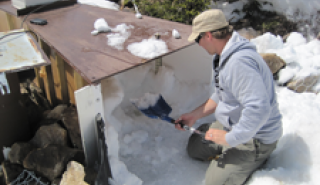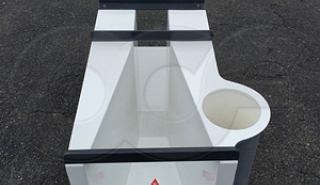 Flow measurement in arctic locations can be extremely difficult. By their very nature, the locations are remote, equipment is limited, flows are highly seasonal, and frost heave is an ever-present concern. Of these problems, frost heave can be the most difficult to resolve.
Flow measurement in arctic locations can be extremely difficult. By their very nature, the locations are remote, equipment is limited, flows are highly seasonal, and frost heave is an ever-present concern. Of these problems, frost heave can be the most difficult to resolve.
Frost heave is a phenomenon where the ground soil expands in cold regions due to the freezing of ground water. As the ground freezes, water is drawn from the lower unfrozen soil to the frost front where it freezes forming a series of ice lenses as the frost penetrates the ground. Soil is displaced as water changes from liquid to solid, expanding 9% in volume. If there is a continuous supply of ground water, mainly due to capillary action, frost heave easily occurs.
Fine grained soils (particularly silty soils) are frost susceptible. Their pore structure allows the capillary movement of water but is fine enough to support ice lensing. Clays impede water flow and so the development of ice is retarded. A sandy soil will allow frost to penetrate deeper than either clay or silt rich soils.
For large ground heaves to form, three conditions are required: frost susceptible soils, ground water, and freezing temperatures in the ground. By eliminating any one of these, frost heave can be essentially eliminated.
Two common methods of reducing the effects of frost heave are insulation and increased depth footings.
Insulation is used to retard geothermal heat loss in the earth, thereby reducing the depth of frost penetration. The insulation layer should be buried at a sufficient depth to protect it from damage and sunlight. Generally 20 to 30 cm [7 7/8-inches to 11 7/8-inches] of fill is considered adequate. Note that a continuous insulation mat must be provided beneath the entire area. The performance of the insulating mat can be significantly increased if clean, nonfrost-susceptible fill is used. Even though the nonfrost-susceptible fill may freeze, frost heave will be within acceptable limits, as ice lenses will not develop.
Non-frost susceptible soils may be too dense to promote water flow (low hydraulic conductivity) or too open in porosity to promote capillary flow. Examples include dense clays with small pore size and therefore low hydraulic conductivity and clean sands and gravels, which contain small amounts of fine particles and whose pore sizes are too open top promote capillary flow.
Increasing the depth of footings is the other common method for dealing with frost heave. Here footings are excavated below the depth of frost penetration. The drawbacks are that a larger excavation area is required and heavy-duty equipment may be necessary to get down to the depth of frost penetration.
An alternative method has been developed where soilbags are filled with coarse materials. The soil bags are placed within the depth in which frost heave would usually occur. The number of soil bags is determined through the specified depth for frost heave prevention and the bearing capacity of the ground. Since the soilbags filled with coarse materials have large voids, the capillary water finds it difficult to rise inside the soilbags as well as through the soil ground above the bags.
In general, the most effective method of limiting / preventing frost heave is usually a combination of methods: replacing sub-soil with sand-gravel, insulating mats, and doubled waterproof membranes. Deepened foots, down to the frost level, can be used, but the time and equipment required to deepen footings may well exceed what can reasonably be accommodated in a remote arctic location.
When selecting a primary device for arctic flow measurement, remember that weirs must be vertical to measure flow accurately. Shifting a weir plate out of vertical can result in errors of 25% of the actual flow rate. Additionally, forming the correct upstream weir pool can be difficult give the potential for widely varying flow rates. Maintaining the weir pool may also be difficult as vegetation may quickly grow during the summer season and debris / sediment can quickly accumulate during quick, flashy flows.
Flumes solve some of these issues by eliminating the need for a weir pool. Additionally, corrections for Parshall and Cutthroat flumes have been developed to account for lateral and longitudinal settlement (under free and submerged flow conditions). These equations can be applied to historical data to correct for the effects of frost heave, settlement, etc. when a flume is found to have moved out of its original position.
Source: Matusoka, H. and Liu, S., A New Earth Reinforcement Method Using Soilbags, 2006





